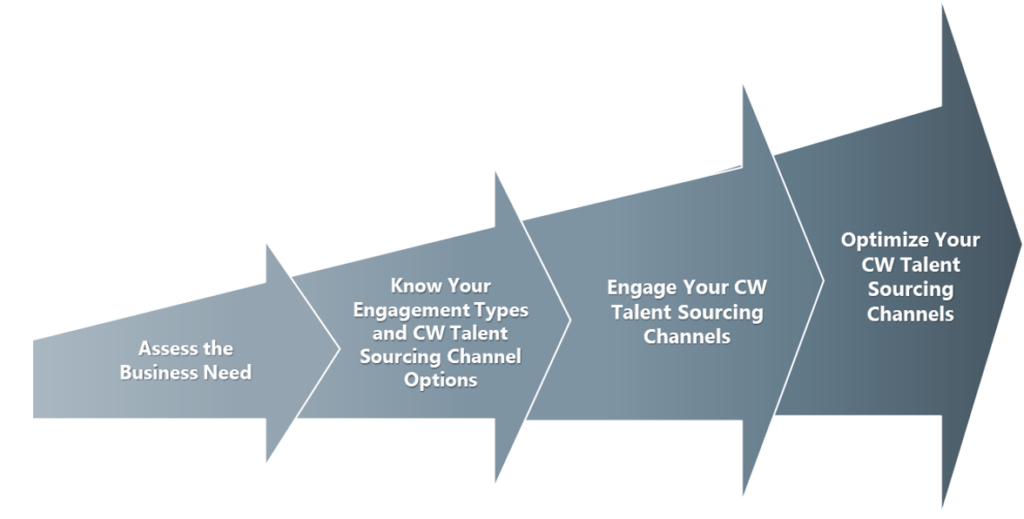Given the war for talent and tech advances, we have the ongoing evolution of CW program management and talent marketplace access points, resulting in multiple sourcing options for programs. This has also led to CW programs recognizing the emergence of these varied talent sourcing channels and establishing a management plan to leverage the benefits and operational requirements of each.
Three of the more distinct talent sourcing channels today are traditional staffing partner, direct sourcing and on-demand staffing channels:
Traditional staffing partner channel. The practice of utilizing a third-party recruitment organization/agency to source and identify talent for an engagement manager’s CW service needs. These workers are engaged through the third party for the term of the CW assignment. This traditional channel could also include SOW project talent engagements, or on occasion, a separate talent sourcing channel is created for SOW engagements to be uniquely defined, managed and controlled.
Direct-sourcing channel. This is a targeted, talent sourcing approach where the end buyer organization takes on parts of the talent sourcing process to better leverage their company’s talent brand and build a more strategic and holistic workforce talent pipeline. This channel’s process disintermediation enables companies to build ongoing direct relationships with known, vetted talent and capture incremental savings.
On-demand staffing/gig economy channel. The engagements are between independently represented workers for pieces of work and transacted on a gig basis. Access to this talent (mostly a remote mode engagement) is now more easily facilitated via on-demand/online staffing platforms with either a formal CW program business arrangement or directly with the engagement manager.
Managing the Strategies
For a program to recognize distinct talent sourcing channels, the sourcing channel must meet specific and discrete CW engagement and requirements, such as with an engagement manager or the CW program itself. For example, the CW program needs to establish a strong staffing partner sourcing channel (or a portfolio of staffing partners) to deliver a reliable, cost-effective and low-risk CW service to the organization it serves. Meanwhile, an engagement manager may prefer a more direct approach to sourcing CW talent through an on-demand staffing platform because of speed to fill a position and the fact that on-premise delivery of the CW service is not a requirement.
Assess. As is always the case with innovative management strategies, assessing the business need is a critical first step to ensure you are selecting the best talent sourcing channel to engage. This requires a detailed understanding of the CW talent solution support needed for the client/engagement manager. This step can be done informally through conversation or through a structured data-gathering exercise. The key is asking questions to create the best fit for the most appropriate talent sourcing channel to meet the engagement manager’s CW talent service needs/requirements.
Understand. Another important step is gaining a thorough understanding of the talent sourcing options available to your business. Each sourcing option may present unique benefits or fit based on engagement managers’ need. Understanding these channel options and talent sourcing alternatives will enable you to see the best opportunity to effectively meet your CW program and/or program client’s requirements.
Engage. Once you know the problem you are solving and the options for how to solve it, you are ready to map the engagement manager need with the best talent sourcing solution and begin engaging the partners or talent directly within the correct sourcing channel/methods. There are subtle process nuances to be aware of that allow you to navigate these talent sourcing channels and methods successfully.
Optimize. Optimizing your leverage of multiple talent sourcing channels is an ongoing effort to develop the partners and talent within a channel to ensure a talent sourcing channel option is best positioned for success. And as new talent sourcing channels emerge, it is important to keep a watchful eye on the impact they may have on other established talent sourcing channel options. For example, as new talent sourcing channels are leveraged, a program will become less reliant on the traditional talent sourcing channels/methods. Thus, the program will conduct staffing partner portfolio rationalizations to ensure that appropriate, profitable volume levels are sustained for their top-performing traditional staffing partners.
As is the case with any CW program capability change, basic capability infrastructures will need to be updated and enhanced, such as standard operating procedures and rules of engagement, in order to competently incorporate and integrate the new CW program capability enhancement.
Finally, CW program management will need to track and measure talent performance levels by talent sourcing channels and determine the best source for specific skill sets that meet the needs of your organization’s CW service requirements.










